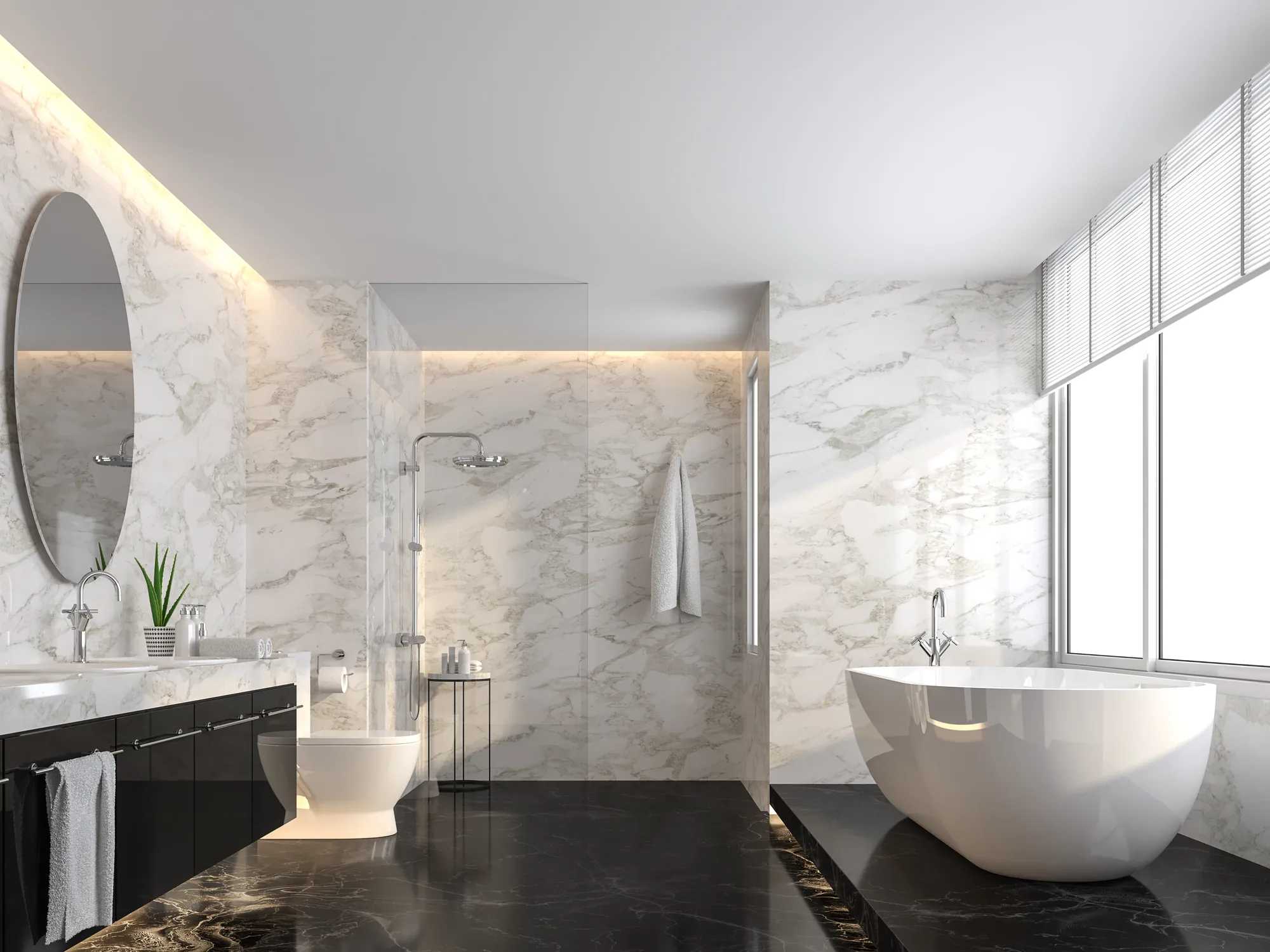
If your bathroom offers limited space, you’re probably assessing how to make the most of your space while having either a bathtub or a shower. In this article, we’ll uncover the advantages and disadvantages of each as well as the options available for minute bathrooms.
Get a FREE Brochure
Simply complete our form to see a full range of bathing solutions & their key features. It takes no time at all!
- Bath Vs shower for bathroom accessibility
- Advantages of a small bathtub
- Advantages of a compact shower
- Types of baths for small bathrooms
- Accessible showers
- Walk-in baths
- Which is best for bathroom accessibility?
Bath Vs shower for bathroom accessibility
If you have limited bathroom space and also need support to assist with mobility accessibility in the bathroom, you might be wondering whether a bathtub or shower is the best solution.
Baths notoriously take up more floor space than showers because you need to lie down or sit in them. However, showers aren’t always viable if you have serious mobility concerns and need support when showering.
Advantages of a small bathtub
- Baths can enhance your mood and help you to relax. Laying in warm water can provide temporary relief from the pressures of everyday life. Submerging in warm water can soothe feelings of sadness and stress and provides some security for your mental well-being in that very moment.
- Improve your sleeping pattern. If you struggle to unwind and rest, a bath can instigate melatonin production, which signals to your body that you’re ready to sleep.
- Relieve muscle pain and aches. Heat can encourage blood to flow around your body, which is important for circulation but can also assist with soothing sore or tight muscles. Adding Epsom salts into warm water can help to reduce joint inflammation and help you to relax.
- Boost your immune system. If you have a cold or flu, soaking in a warm bath can help you to feel better. Steam expelled from a hot bath can help with chesty coughs and blocked sinuses to help you feel better.
Advantages of a compact shower
- Showers reduce time, water and running costs. Replacing a bath with a compact shower has to have a positive impact on the environment by consciously reducing your water waste.
- They’re easier to clean and maintain. You don’t have to lean over in awkward positions to keep a shower clean compared to wiping down a bath. Simply spray and wipe down to remove scum and watermarks.
- They maintain a consistent temperature. Unlike baths, showers run water at the same temperature, so you don’t have to encounter colder smells the longer you’re soaking. The best showers maintain a consistent pressure and temperature, even if someone is using a tap or flushing the toilet.
- Showers can be more hygienic. In a shower, all body products rinse away straight down the drain, rather than you soaking in dirty water. Plus, it’s much easier to rinse away hair and body products in the shower, compared to the bath where they’re more likely to remain.
Types of baths for small bathrooms
Below are some of the bathtub options if you have limited space in your bathroom.
1. Inset baths
An inset bath is suitable for bathrooms with a narrow width, as these baths are enclosed by three walls. They’re a suitable space-saving option, as they fit into the alcoves to maximise your bathroom’s space.
2. Shower baths
This is the best option if you can’t decide between a bath or a shower. This combination of a bath and a shower truly does give you the best of both worlds, and they fit against a wall while leaving enough space in the bathroom for a sink, a toilet and optional storage.
3. Compact baths
A compact bath has a smaller length and width compared to a traditional bath, making it suitable for bathrooms where a full-size bath isn’t possible. Compact baths typically have steeper edges to provide extra depth compared to a full-sized bath. However, they’re not the best option if you’re on the larger size.
4. Corner baths
A corner bath makes a great option for small bathrooms because they slot into a corner and fit into the wall. Compared to straight-edge baths, they don’t reach as far or as wide into the bathroom space. They can reduce floor space, providing additional room for you to walk around your bathroom. There’s also the option of left-hand or right-hand fittings to personalise your space.
5. Walk-in baths
A walk-in bath includes a door that allows you to enter and leave without having to step over the bath. This is probably the best option if you need assistance with accessibility, and it also avoids injuries from falling over or hurting yourself when getting in and out of a traditional bath.
Accessible showers
Accessible showers are isolated and include a door, making it easier for you to enter and leave. They’re typically more spacious than traditional showers to allow room for a wheelchair, and they usually have a textured surface to help prevent slips.
There are many advantages to accessible showers, especially if you require more support when you’re showering.
1. They’re wheelchair-friendly
If you have a waterproof wheelchair, an accessible shower is an excellent option because they can often provide enough space for you to sit in your wheelchair while showering.
2. They’re easier to clean
Accessible showers are usually equipped with grab bars, sometimes seats and textured floors. These features provide more accessibility and pose fewer safety risks for those with limited mobility when showering and cleaning the shower area.
3. They can increase independence
If you have limited mobility, you might rely on family members or carers to assist with your well-being. Thankfully, accessible showers can provide you with more independence, so you can shower yourself without requiring support. This is primarily because of being able to take your wheelchair into the shower area or having grab bars to hold onto while you’re showering.
Walk-in baths
The most popular accessible bath is a walk-in option. These make it easier to get in and out of the bath if you have mobility concerns. There are many benefits to walk-in baths, which are stated below.
1. It’s easier to get in and out of the bath
The biggest advantage of walk-in baths is the door feature, which makes it more accessible to get in and out of the bath compared to a traditional tub. You don’t have to struggle over bathtub walls to get in and out, which limits your risk of injury.
2. They’re relaxing and can help with aches and pains
Who doesn’t love a bath after a stressful day or if you’re prone to aches and pains? A walk-in bathtub provides a safe, accessible space for you to unwind and soak your muscles and joints when a traditional bathtub might not be a viable option if you have difficulties with mobility.
3. Includes a seat for support
Most walk-in bathtubs incorporate a seat, so you don’t have to lay down completely, removing the difficulties that you can encounter with getting in and out of a bath when you have immobility concerns.
Which is best for bathroom accessibility?
A walk-in shower might be the best option for bathroom accessibility and smaller bathroom spaces. Walk-in showers remove the need to bend down, which can be the biggest dilemma for those with mobility concerns.
These showers are designed to provide ample room for wheelchair access, too, allowing you to shower without anyone to assist you. Additionally, they’re equipped with grab bars and a textured surface to support you while you’re showering and reduce the chances of slips and falls.







